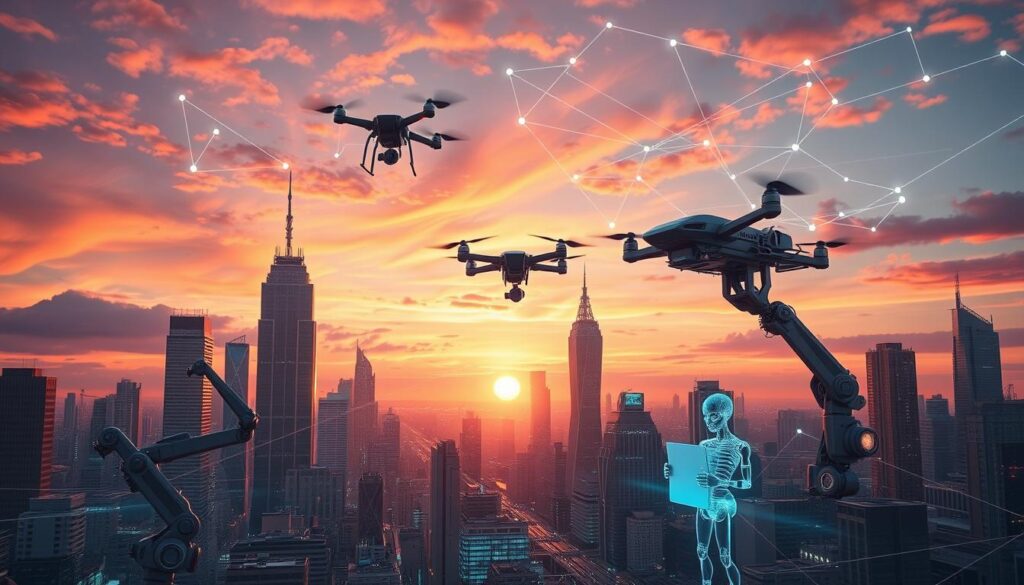In 2024, Generative AI (GenAi) has changed how businesses work. It has made them more productive and efficient. GenAi uses smart automation and predictive analytics to cut down on manual work and costs1.
It also makes customer service better by offering tailored experiences. This includes personalized marketing and accurate product suggestions. It’s a big step forward in digital transformation1.
GenAi leads in innovation, using deep learning models like LLMs and GANs. These models can create realistic content like text, images, and videos. This boosts creativity and precision in many fields. A 2023 report by McKinsey & Company shows GenAi could add up to $4.4 trillion to the global economy1.
The GenAi market was worth $21 billion in 2023. It’s expected to hit $136 billion by 2030, growing at a rate of about 36% annually2. This growth shows GenAi’s huge potential in making businesses faster, cheaper, and more scalable. It’s changing many industries, from healthcare to finance12.

Key Takeaways
- GenAi significantly reduces manual effort and operational costs through intelligent automation and predictive analytics.
- Advanced models like LLMs and GANs enable the generation of highly realistic human-like content.
- GenAi could contribute up to $4.4 trillion annually to the global economy, driving digital transformation1.
- The GenAi market is growing rapidly, expected to surpass $136 billion by 20302.
- Real-world applications span numerous industries, offering transformative impacts12.
Introduction to GenAi and Its Impacts
GenAi is a big step forward in artificial intelligence. It creates new content from lots of data. Unlike old AI, GenAi uses deep learning to make content that looks like it was made by a human. This helps many industries in new ways3.
What is GenAi?
GenAi means Generative Artificial Intelligence. It’s a part of AI that makes new content like text, images, and videos. It uses smart algorithms like GANs, VAEs, and Transformers. These help GenAi make things that look real and new3.
Historical Context and Evolution
AI has changed a lot over time. First, AI was simple and only did one thing. Then, Neural Networks came along and AI could do more complex tasks. This led to GenAi, which can make things that look like they were made by a human3.
This change has made many industries better. It has made processes easier and created content that feels human.
Importance in Modern Automation
GenAi is key to making things better and more efficient today. It can do hard tasks, which helps in many areas like healthcare and finance3. For example, tools like ChatGPT and Google’s Gemini are changing how businesses talk to customers4.
These tools use GenAi to understand and answer questions. This makes customer service much better.
As GenAi gets better, it will keep making a big difference. It will bring new and smart ways to solve problems.
| Aspect | Traditional AI | GenAi |
|---|---|---|
| Scope | Task-specific | Content generation |
| Key Algorithms | Linear & Logistic Regression, Decision Trees | GANs, VAEs, Transformers |
| Applications | Prediction, Classification | Text, Images, Audio, Video |
| Advancements | Image and Speech Recognition | Creative and Synthetic Content Creation |
The Role of Tapouts in Omnichannel Marketing
Using tapouts in omnichannel marketing boosts customer interaction and sharpens digital marketing plans. Let’s explore their main roles and importance.
Defining Tapouts
Tapouts are the exact actions users take when they tap on digital content. In omnichannel marketing, these actions give brands key data. This data helps create a smooth customer journey across different platforms and channels5.
Significance in Customer Engagement
Marketers can learn a lot from tapout data. They get insights into what users like and how they behave. This detailed info lets them craft marketing plans that fit each customer’s needs, making their experience better6.
For instance, generative AI helps brands make ads that really speak to people. This makes ads more engaging and relevant5. Retail and Telecommunications use this data to make their marketing more personal. They use AI to tailor their messages, making customers happier6.
The Central Trend of Screen Engagement
In today’s world, tapping screens is a key way we interact with digital devices. This trend is changing how we use our devices and how we react to digital content.
Understanding the Screen Tapping Phenomenon
Screen tapping is now a main way for young people to interact with digital devices. In the UK, 79% of teens aged 13-17 use generative AI tools and services7. This shows a big interest in screens among the young.
Platforms like Snapchat, used by 51% of kids aged 7-17, play a big role in this trend7.
How It Shapes Consumer Behaviour
Understanding screen engagement helps us see how people behave. Businesses use this info to make their digital content more appealing.
For example, 67% of 16-24-year-olds are concerned about the impact of generative AI7. This shows they are both cautious and engaged with digital stuff.
Also, 58% of internet users just use generative AI for fun8. This shows how people want fun and interactive digital experiences.
This knowledge helps businesses make marketing that really speaks to what people want and need.
| Age Group | Usage (% of online users) |
|---|---|
| 13-17 years | 79% use generative AI tools and services7 |
| 16 and above | 23% use ChatGPT7 |
| 7-17 years | 51% use Snapchat My AI7 |
In short, screen engagement is a key trend for businesses to keep up with. Knowing how digital interaction affects behaviour helps businesses create better marketing. This leads to more engagement and happiness from consumers.
GenAi: Enabling Marketing Innovation
In today’s marketing world, GenAi has brought big changes. It’s changing old ways and adding new ways to connect with customers and make campaigns better.
The Intersection of GenAi and Tapouts
GenAi and tapouts are leading to new ideas. GenAi uses data from customer interactions to make content just for them. This makes marketing more effective.
Generative AI can make and improve lots of data and content. This helps us keep up in a competitive world9.
AI also helps keep customers loyal by doing better than humans alone9. Using GenAi in customer retention means we can offer things that really match what customers want. This changes how we see the customer journey9.
Case Studies of Successful Implementations
Many companies have seen great results with GenAi. For example, Coca Cola used GenAi to make new drinks like Coca-Cola Sugar Y300010. Unilever, Nestlé, and Mondelez also used GenAi for ads10.
These examples show how GenAi helps businesses make marketing that changes and meets customer needs.
GenAi also makes marketing work better. It could make marketing 15% more efficient, saving about $463 billion a year10. GenAi can learn from big datasets and work well in new situations10.
Foundation models like GPT-3 by OpenAI and Microsoft are changing how we make content. They’re used in services like Bing and ChatGPT10. This new technology is leading to a big change in marketing.
The Customer Journey with Tapouts
The customer journey in today’s world is all about touchpoints. These are where customers meet a brand. It’s key for a good user experience. Businesses must map these interactions well to keep things consistent and engaging.
Mapping Omnichannel Touchpoints
Understanding where customers meet a brand is crucial. This helps create a smooth experience. For example, HCA Healthcare uses a virtual AI assistant for smooth transitions between shifts11.
This approach can help other sectors too. GenAi can make the customer journey better.
A good map of touchpoints includes digital and physical channels. Learning from others, we can use AI and machine learning early on12. This first step is important for a good start.
Enhancing User Experience Through GenAi
GenAi changes the game by analysing data from many channels. It makes interactions better. Sales and marketing teams get a lot from GenAi, making experiences more personal11.
GenAi also frees up time for more important tasks. This boosts efficiency and happiness.
GenAi is getting better, and soon, 30% of new drugs and materials will come from it11. In marketing, setting KPIs early helps measure success and improve strategies12.
Virtual assistants and AI analytics also help keep an eye on app performance12. This makes experiences better and keeps brands in tune with customer needs.
By using GenAi, businesses can offer smoother, more personal interactions. This builds loyalty and satisfaction. Staying up-to-date with AI keeps companies ahead, providing a top-notch user experience.
| Stage | Key Activities | Expected Outcomes |
|---|---|---|
| Awareness and Research | Integrate AI and ML capabilities | Enhanced brand perception, increased initial engagement |
| Trial and Learning | Utilise Free Tier and workshops | Improved understanding of AI tools, higher trial conversion |
| Implementation Planning | Define KPIs and metrics | Clear performance benchmarks, targeted strategy |
| Optimisation and Scaling | Monitor performance, scale based on success | Sustained user engagement, adaptive improvements |
Future Prospects of GenAi in Marketing
Looking ahead, GenAi in marketing is set for big changes. New trends and automation advancements will shape the marketing world. We’ll see more hybrid roles, like AI-assisted content and SEO specialists, and a need for AI marketing strategists and creative technologists13.
This change shows the importance of tech skills. It’s crucial to train employees to work with GenAi systems14.
Emerging Trends to Watch
One key trend is the merging of roles in marketing teams. GenAi has made old roles like content creators and SEO specialists less needed. Now, we have AI model trainers and creative technologists, showing how marketing is changing13.
There’s also a move towards hybrid roles. This means tech skills are now essential for marketing teams13.
The Evolution of Automation in the Next Decade
In the future, GenAi will focus on making customer interactions more personal and interactive. It will process data in real-time, helping businesses connect better with customers14.
This change will require a culture that values innovation and learning. It’s about using AI to its fullest potential13.
As agentic AI becomes more important, marketing leaders need to be forward-thinking. They must understand AI’s capabilities and make decisions based on data15.
The future of GenAi in marketing is about creating smart strategies. These strategies should adapt quickly to market changes, keeping businesses ahead15.
Source Links
- https://www.firstsource.com/blog/genai-infused-automation-the-next-wave-of-digital-operations/
- https://medium.com/@ravityuval/the-rise-of-service-as-a-software-as-a-service-how-genai-is-transforming-the-saas-landscape-05a418a73a82
- https://www.linkedin.com/pulse/introduction-ai-genai-ml-overview-key-concepts-malaviarachchi-tltac
- https://www.imperial.ac.uk/students/academic-support/ai-and-study-guidance-hub/introduction-to-ai/
- https://isg-one.com/articles/the-cognitive-enterprise–how-to-improve-operations-with-generative-ai
- https://advertising.amazon.com/blog/generative-ai-advertising
- https://www.ofcom.org.uk/internet-based-services/technology/gen-z-driving-early-adoption-of-gen-ai/
- https://icma.org/articles/pm-magazine/using-generative-ai-community-engagement-why-and-how
- https://www.forbes.com/sites/sunshinefarzan/2024/02/25/harmonious-symphony-genai-takes-center-stage-in-marketing-innovation/
- https://link.springer.com/article/10.1007/s11747-024-01044-7
- https://tunehq.ai/blog/genai-use-cases-for-every-industry
- https://raviintodia.medium.com/amazon-bedrock-customer-journey-75a550ac257c
- https://www.forbes.com/councils/forbescommunicationscouncil/2024/10/21/navigating-the-future-how-genai-is-transforming-marketing-teams/
- https://www.experian.co.uk/blogs/latest-thinking/data-insights-and-analytics/the-future-of-business-with-gen-ai/
- https://www.cdotrends.com/story/4254/future-genai-increasingly-agentic
















